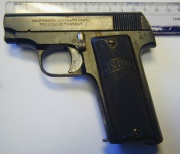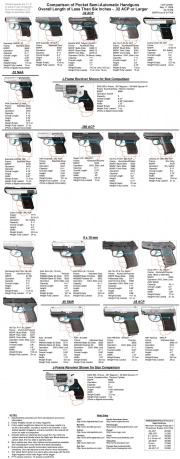Pocket pistol
In general use, the term pocket pistol is not considered a pejorative term.
Contents |
[edit] History
The original 19th century vest-sized pocket pistol, the derringer, which developed from the Philadelphia Deringer, is typically no longer widely used for concealed carry (except in .357 Magnum calibers) with most preferring more rounds of small caliber cartridges in a auto-loading pistol design to provide increased self-defense capability extending beyond one or two shots. Likewise, but while still retaining moderate amounts of popularity, short-barreled ("snubnose") revolvers are similarly not as widely used as pocket pistols today as they were during the 1950s and earlier.
The first widely used and successfully sold pocket pistols were sold in blowback designs, such as the Raven Arms MP-25.
More recently, modern locked-breech designs, such as the Kel-Tec P-32 and Kel-Tec P11, have become more popular through providing an option for carrying larger, more powerful, caliber sizes, while additionally including more safety features than were included in the older blowback designs.
[edit] Typical usage
The typical usage of a pocket pistol is for close range self-defense, often serving as a deep concealment backup gun to a much larger handgun. Pocket holsters are highly recommended for the safe carry of pocket pistols, with standard practice being to carry the holster (sometimes with a second magazine sub-pocket stitched into the holster) in a front or rear trouser pocket with nothing else carried in the pocket that could snag on the gun when drawn. The most popular pocket holster designs are typically made of form-fitted leather, with a heavy layer of leather worn outward from the body to prevent printing of the gun outline on tight clothing.
Pocket pistols are carried with a round chambered, and with a safety engaged (ON), for single-action designs. However, with the 5 to 6 lbf (22 to 27 N) trigger pulls seen on double-action-only long trigger pull handguns without any external safety, and with a round chambered, the use of form-fitting leather holsters prevents inadvertently discharging the gun while it is carried, in much the same way that a revolver can be carried without an external safety. The use of moisture and vapor-barrier layers in the holster stitched closer to the body in the holster is recommended to prevent damaging the finish of the pocket pistol due to sweat. This extra layer also serves to increase carry comfort, and to prevent chapping or blistering the skin under the holster due to repetitive motion rubbing or friction that can occur while walking, jogging, or running.
Pocket pistol users include both concealed handgun licensed civilians and police officers, desiring a self-defense gun, or desiring to carry a backup gun. Aiming is typically intended for point and shoot, only, with one-handed pistol operation, unlike the practice with small-caliber target pistols which are instead usually fired with two-handed stances, and while carefully aligning the front and rear sights. The typical effective range for pocket pistols is 3 to 7 yards (2.7 to 6.5 m). Pocket pistols are typically made with rounded edges, with few controls, to prevent snagging on the draw.
Range practice, at least monthly, is recommended to maintain proficiency and accuracy. Pocket pistols are not typically pleasant to shoot, having considerably more recoil than seen with larger full-size or service-size semi-automatic pistols. Shooting more than 70-80 rounds will often cause a blister to form on the trigger finger, even with extremely smooth triggers and trigger guards. Additionally, the web of the thumb, particularly the basal bone, can experience significant punishment after prolonged firing. For proficiency, firing roughly 50 rounds monthly through a pocket pistol is typically adequate to maintain one's accuracy, while avoiding getting trigger-finger blisters.
[edit] Caliber sizes and safety features
Pocket pistol caliber size is typically .22 LR, .25 ACP, .32 ACP, and 380 ACP in older hammerless, blowback designs; and .32 ACP, .380 ACP, and 9 mm Luger in concealed-hammer, locked-breech designs. There are also single-stack 6+1 pistols in .45 ACP or .40 S&W such as the Springfield Armory Micro Compact LW and the Smith & Wesson SW990L which technically qualify as pocket pistols or holdout guns.
In general, the newer concealed-hammer, locked-breech designs are much more resistant to accidental discharges, having modern hammerblock and other safety features that prevent pistols from firing when a round is chambered and the pistol is accidentally dropped on its muzzle.
[edit] Popularity
Pocket pistols are typically derided by gun enthusiasts who claim that they provide inadequate self defense. Likewise, pocket pistols, due to their typical low cost, often are lumped with Saturday night specials by those not favoring the use of such guns . Hence, pocket pistols are less popular with a larger cross-section of the general US population than larger and more expensive self-defense handguns. Still, the numbers sold speak to a wide degree of popularity, with some models having been sold in quantities in excess of 3 million over 30 or more years.
This popularity seemingly agrees with John Lott's research, who argues in More Guns, Less Crime that:
"While news stories sometimes chronicle the defensive uses of guns, such discussions are rare compared to those depicting violent crime committed with guns. Since in many defensive cases a handgun is simply brandished, and no one is harmed, many defensive uses are never even reported to the police. I believe that this underreporting of defensive gun use is large, and this belief has been confirmed by the many stories I received from people across the country after the publicity broke on my original study." (More Guns, Less Crime p.2)
If Lott is correct, then simply having a gun on one's person, even a pocket pistol, may suffice to help prevent the majority of crimes from being committed. After all, no one usually desires to be shot, even with a small bullet. If the prevention of a crime usually results from simply brandishing a gun, then the stopping power of the gun, even a pocket pistol, may not matter.
[edit]
Similar terms include Saturday night special, mousegun, and junk gun. The term pocket pistol typically encompasses a superset of most all of these handguns, without the pejorative issues often seen with the terms Saturday night special and junk gun.
[edit] Typical pocket pistols
- Blowback Operation, Single-Action
- Raven Arms MP-25 (.25 ACP)
- Bryco Arms P-38 (.32 ACP and .380 ACP)
- Walther PP (.380 ACP, .32 ACP, .22 LR, and .25 ACP)
- Locked-breech Operation, Double-Action-Only
- Kel-Tec P-32 (.32 ACP)
- Kel-Tec P11 (9 mm)
- Revolver
- Velo-dog (.22 velo-dog cartirdge)
[edit] References
- McLeod, Terence (2001), written at Boulder, Colorado, Concealable Pocket Pistols, How to choose and use small-caliber handguns, Paladin Press. Concentrates on blowback operation pistols, only.
[edit] See also
[edit] External links
- Smallest Guns A useful and unique website listing a good deal of information and links about many pocket pistols.
- Defining A True Pocket Pistol

